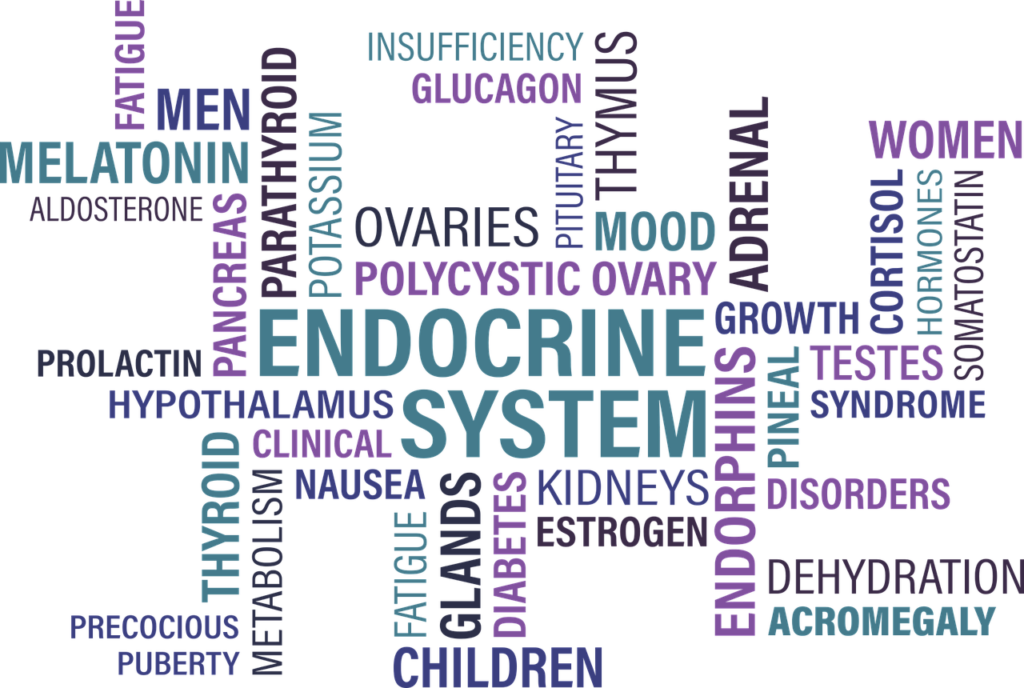This table outlines some of the common lab tests ordered by endocrinologists & provides some information about them.
| Test | What it means | Average/Normal range |
| Creatinine (Cr) | A waste product of metabolism: excreted by the kidney: if it is ↑means kidney function is lower. | Usually < 1.1 to 1.3 |
| eGFR | An estimate of kidney function. Calculated based on age, gender, Cr, weight may overestimate loss of kidney function | >60-90 depending on protein in the urine |
| Micro-albumin/ Creatinine Ratio | Urine test to determine “early” damage to the kidney from high blood glucose or blood pressure | < 30 mg/ gm |
| Creatinine, urine | Does not directly indicate kidney disease is affected by body size and the volume of the urine | Range ~ 600 mg to ~ 3 grams /day |
| ALT AST Alkaline Phosphatase | Liver enzymes↑ levels may mean liver disease often mild-moderate ↑ in “fatty liver” in overweight or diabetic patients | Usually – but not always- 2-3 x values may indicate medical liver disease. |
| Bilirubin (yellow pigment) | Produced when red blood cells break down. The liver takes it up & excretes it in the bile may be ↑ in liver disease or hemolysis or | ↑ levels in: Liver diseaseHemolysisGilbert syndrome |
| TSH | Measures pituitary hormone that tells the thyroid gland to make thyroid hormone precisely according to our body’s need↑ level means “low thyroid hormone level↓ level means “too much thyroid hormone” | Range (0.5 to 2.5 or so) |
| Free T4 | The actual thyroid hormone level may be “normal” in mild cases of overactive or underactive thyroid | Range (0.8 to 1.8) |
| Free T3 | One of the thyroid hormone (active form)Blood levels is not always reliable and useful if investigating overactive thyroid. | Range (2.4-4.2) |
| A1c | Average blood glucose over the last 3 months | Normal <5.7 Prediabetes: 5.7-6.4 Diabetes: ≥ 6.4 |
| C-peptide | Levels indicate blood insulin levels (↓ type 1 diabetes ↑ insulin resistance) | Range (Fasting) 0.5 to 2 ng/mL |
| Lipid Panel LDL-C HDL-C Triglyceride Cholesterol/HDL ratio | Measures blood fat levels “bad cholesterol good cholesterol” and “other fat” Measures cardiac risk | Desirable LDL-C<100 mg/dL HDL-C>55 mg/dL TG <150-199 mg/dL Chol/HDL<4.0 |
| Testosterone Total T Free T Bioavailable T Levels in MEN | Level of the male sex hormone: Initial test More accurate biologically More consistent /accurate | 300 to 1000 ng/dL6.6 to 21.5pg/mL |
| Female Hormone Levels ESTRADIOL Luteinizing Hormone Follicle Stim Hormone PROGESTERONE | Measures the dominant estrogen Pituitary hormones stimulate ovaries to produce estrogen & progesterone Ovarian hormone useful in checking ovulation | E2: 27 – 161 pg/mL LH: 2 to 10 mIU/mL FSH: 3 to 9mIU/L P4:5-20 ng/mL(Day 21) |
| Prolactin | The pituitary hormone stimulates milk production & and ↑ it reduces LH/FSH & testosterone & estrogen levels. Can be from medications or a pituitary tumour. | Normal <20 ng/mL |
| DHEAS | A weak androgen made by the adrenal gland Decreases by age Mildly ↑ – possibly PCOS Very ↑↑- adrenal tumour | Normal (age dependent) >700 ug/dL – r/o adrenal tumor |
| Cortisol (Blood) | The main hormone (stress hormone) is made by the adrenal gland. Best measured ~8 am. Usually, the normal range may include some patients with adrenal disorders | Normal 5-20 ug/dL (actually ~ 10-20ug/dL) |
| Cortisol (Saliva) Usually at 11 pm at home | At 11 pm, it should be low. ↑ in Cushing syndrome | Normal <0.09 mcg/dL |
| Parathyroid (PTHi) | A hormone which helps the body manage calcium balance. | Normal 14-65 pg/mL |
| CTX (C-terminal telopeptide of type 1 collagen) | The blood test measures bone turnover (bone loss) | Normal 300-600 pg/mL |
| Ferritin | The storage form of Iron. Useful in diagnosing iron deficiency anaemia (usual ferritin will be <30 mcg/L) | Range: Men:24-336 mcg/L Women: 11-307 mcg/L |
This information is for general knowledge & is not a substitute for medical advice your doctor recommends
Post Disclaimer
We are not your healthcare provider, and your use of this website does not establish a patient-client relationship. All the information contained on this website is for informational purposes only. No material on this site is intended to be a substitute for professional medical advice (diagnosis, treatment, testing or nutritional information). Always seek the advice of your physician or qualified healthcare provider with any questions you may have regarding medical or health-related conditions or treatment. Your healthcare provider knows your condition or situation well and can give you specific advice which would be appropriate for your condition/situation. Your healthcare provider can also guide you more accurately about injection techniques, dietary interventions and the use of medical technology that is most pertinent and suitable for you. Please do not disregard professional medical advice or delay in seeking it because of something you may have read on this website.

